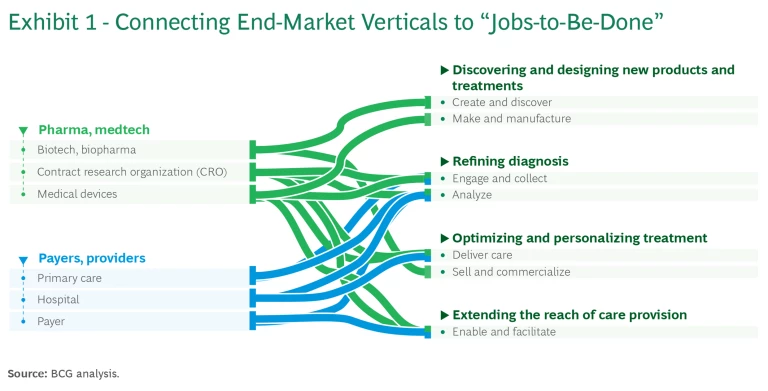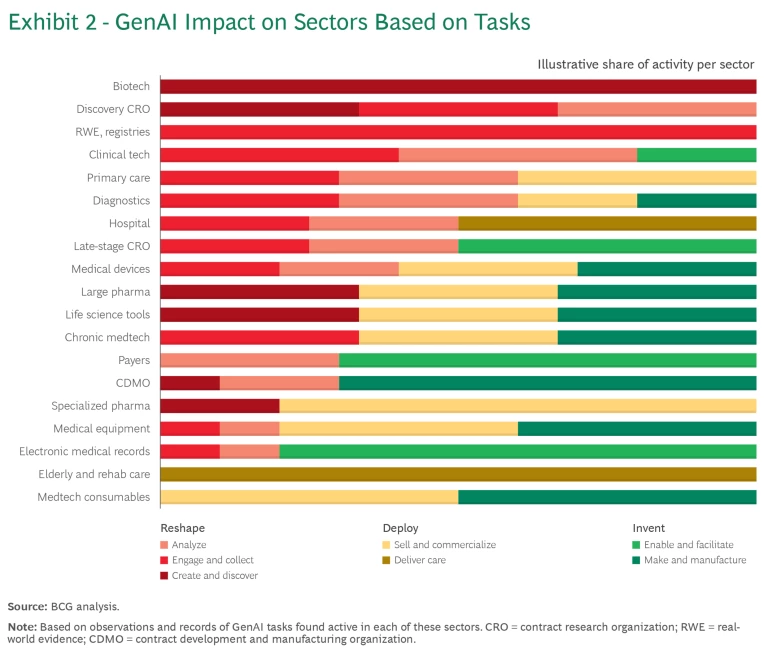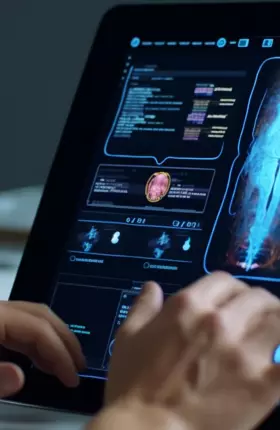Generative artificial intelligence (GenAI) is poised to transform the health care industry . It is already beginning to have an impact in fields ranging from R&D to care delivery to precision medicine. GenAI is typically defined as a set of algorithms capable of producing seemingly new content such as text, images, audio, and video derived from a vast quantity of unlabeled data.
GenAI is poised to transform the health care industry.
There is often a temptation to think of disruptive innovation as distant and futuristic. With GenAI, that perspective no longer applies. The disruption is already here. Indeed, the use of generative AI algorithms was already established even before the release of large language models like ChatGPT. Now, across health care sectors, the pace of change is accelerating. GenAI and the related tools may fundamentally shift the value proposition for many health care organizations. From the experience of the past few years, we believe the effects will be centered on four key hot spots:
- Discovering and designing new products and treatments, particularly in biopharma and medtech, supported by life sciences and related services sectors
- Refining diagnosis, raising its speed and accuracy by accepting a wider range of input data beyond basic electronic health record (EHR) data—for example, leveraging wearables and population health metrics
- Optimizing and personalizing treatment, enhancing individual-level patient planning through population-based analytics and improving treatment itself
- Extending the reach of care provision beyond traditional brick-and-mortar access, augmenting in-person clinician interactions to serve more people at lower cost with higher-quality outcomes
These hot spots, while centers for current and potential future fundamental shifts, are not the only areas of impact. Beyond these hot spots, we are seeing strong use cases in a large range of areas (for example, sales and marketing, medical and legal writing) where efficiency is changing how the work is being done. Investors and health care companies are now positioning themselves to take advantage of GenAI. They are developing hands-on proficiency with data-driven innovation and an understanding of the opportunities and risks. They are stretching their experience from GenAI innovation across multiple areas: product discovery and development, manufacturing optimization, acceleration of their commercial presence in the market, support for physicians and other health care professionals, and the improvement of patient relationships. They are also seeking to understand and navigate, and potentially help shape, the relevant policies and regulations.
The rise of GenAI brings ample opportunity for investors to fund disruptive GenAI efforts: supporting many companies through the GenAI transformation, making the impenetrable “black box” of an AI application more transparent, and offering connections and support beyond the reach of individual companies. The opportunities will take many forms, including hybrid tech-health startups, tech company scale-ups, and mature health care operators making the inevitable shift. Investors could engage with the transition through companies that are one step removed, such as GenAI-enabled analytics companies that serve the health care space through for instance real-world data, real-world evidence (RWD/RWE) and bioanalytical tools.
In such a dynamic environment, investors often wonder how to approach the market and make investment decisions. We propose a model for health care investors to get beyond the hype. It is based on the value proposition of GenAI’s transformative potential for both the old and the new: a compass for navigating investments and supporting them toward a beneficial future.
There are critical limitations, which investors can help health care companies to navigate. Access to large pools of data, which is necessary for training the algorithms, will be constrained by laws, privacy concerns, cybersecurity considerations, and the need to validate results. Forward-thinking organizations are taking the appropriate measures including setting up responsible (Gen)AI governance models to ensure that the appropriate risks are managed accordingly. Upcoming regulations, including the new European Union AI Act, may impact the pace of innovation while providing safety and mitigating risk. The impact of the change is affecting, and will continue to affect, a wide range of stakeholders, and that change will need to be managed because the technology may not yield full value at first.
The health care field is primed for GenAI, and the need and potential are vast. The investor community in health care is poised to add significant value to the ecosystem. Individual investors will need to carefully plot the road ahead to ensure that they realize this potential (emphasis on value/impact), avoid falling behind, or avoid being hype-driven. Big changes are already underway, and today’s decisions will determine what comes next.
Tasks and Outcomes in Tomorrow’s Health Care
To understand the impact of GenAI on the health care ecosystem, we focus on the tasks and outcomes performed. This requires moving away from traditional end-market verticals to gain a deeper understanding of the underlying activities and potential changes. For example, instead of asking how GenAI will affect nursing or radiology, we ask how it will change the tasks of engaging with patients, managing images, reading charts, and monitoring patient health. This approach is based in part on the “jobs-to-be-done” concept championed by innovation theorist Clayton Christensen, in which roles are considered in light of the work accomplished, rather than the formal job boundaries.
Health care is traditionally viewed as end-market verticals, but a jobs-to-be-done view is better suited to tease out the impact of GenAI. Exhibit 1 shows a simplified view of the relationship between these two perspectives. The left column shows the traditional health care verticals, such as the biopharma, hospital, and payer sectors. The thick lines show their connections to the health care jobs-to-be-done (also referred to as tasks) in the right column. While these tasks cross sector boundaries, some traditional sectors are expected to be more impacted, driven by how much they rely on each task.

The BCG GenAI health care value proposition model simplifies the industry into seven broad tasks, each with its own sets of activities. Although it is difficult to predict the exact future because of the speed of technological progress and the many uncertain factors involved, these four hot spots are already experiencing change.
Discovering and Designing New Products and Treatments
This is the domain of generating new products and clinical offerings, including pharmaceuticals and medical devices. These R&D tasks include research on biochemistry and the human body, biopharma, life-sustaining treatment, medical devices, and clinical technologies.
Key Tasks
- Create and discover. GenAI is making fundamental changes to the way pharmaceuticals and medical devices are discovered, designed, and developed. AI systems analyze large volumes of data, looking for patterns to identify drug targets. Responding to natural-language prompts, GenAI can also rapidly generate and optimize the 3D structure of molecules and create simulations that can help the design. This is an area of transformative impact for GenAI, which can augment and accelerate research as well as development.
- Make and manufacture. GenAI-enabled innovations will improve industrial efficiency, with advances leading toward the factory of the future . Given the high degree of automation and the industrial infrastructure already in place supporting biopharma and medtech, GenAI has had a relatively modest impact, deployed primarily to improve efficiency rather than invent new products or reshape processes. Even so, a World Economic Forum and BCG partnership has found that GenAI tools are poised to transform manufacturing operations. In health care, they have proven useful to process engineers optimizing workflows to manufacture therapeutic products, such as monoclonal antibodies and cell therapies. Investments in related data and infrastructure are ongoing.
Refining Diagnosis
GenAI can advance accuracy in the diagnostic elements of medicine: triaging, identifying ailments, capturing physician-patient dialogue, analyzing data, and synthesizing information for use by physicians as they make treatment decisions.
This hot spot applies primarily to health care providers, including general practitioners and specialists, who recognize the immense gains in quality and efficiency, and producers of medtech equipment, who are incorporating GenAI features into products. Other early adopters include innovative biopharma companies and testing firms, such as those working in companion diagnostics, in vitro diagnostics, and genomics.
Key Tasks
- Engage and collect. GenAI facilitates dialogue between medical professionals and their patients. It can significantly raise productivity—for example, by translating encounters into notes, reducing waiting times, ensuring that patients engage with the right level of care provision, and helping identify treatment codes and other administrative details. Some digital companies report back-office efficiency gains as high as 30% for hospitals and clinics.
- Analyze. GenAI transforms the way health care providers offer health optimization and well-being services, conduct preventive medical care, and engage and triage patients. AI-enabled systems analyze masses of unstructured data, including patient examination results, meeting notes, laboratory test samples, and public health data.
GenAI can help unlock this space, especially when unstructured data sets are involved. It can augment and accelerate the synthesis of patient data, improving the speed and quality of individual care. It can also help detect longitudinal patterns in patient health, identify trends, and assist with contact tracing.
Already, AI-based coordination platforms in radiology and diagnostic imaging are bringing together data from a wide variety of sources to improve accuracy and response time. A generative layer expands the value of these technical solutions by embedding the insights into clinical practice, through the creation of summaries, notes, and messaging. The widespread adoption of these applications requires more seamless workflow integration and more closely aligned incentives. For instance, when payers and regulators accept GenAI-related innovation, that makes the use of these tools easier and lowers the costs.
Optimizing and Personalizing Treatment
This use of GenAI applies primarily to providers and diagnostic services. It involves the use of tools that help improve treatment planning and interventions , drawing on advances in data and modeling. As a result, physicians can become better at providing individualized treatment plans and optimizing the use of medications and other treatments.
Key Tasks
Deliver care. GenAI can enhance the tools and planning systems used to provide care. Copilot solutions augment physicians’ decision-making processes. They assist in interpreting images and assessing results, creating a broad source of expanded consultation and up-to-the-minute knowledge. A GenAI app might synthesize physicians’ notes, highlight areas of concern, generate insights for medical reports, identify trends in data for population health assessments, and offer input for better treatment plans.
By taking on some of the interaction and minimizing non-patient-facing tasks, GenAI can enable care systems to provide a much more human experience, expanding the reach and frequency of contact between health care professional and patient. Outcomes might include warnings when a drug or treatment is not working as expected, changes in how in- and outpatient care are optimized for patients, revamped hospital design, and organizational changes in provider networks and payer procedures.
- Sell and commercialize. This task involves the marketing and distribution of innovative health care offerings, as well as increasing personalization. Medtech and biopharma companies use RWD to create RWE, broadening the impact and uptake of their products and services. The data is gathered by engaging with B2B customers—health care providers, hospitals, and payers. GenAI has moderate impact in this area, helping to advance the use of personalized medicine. Additionally, providers and payers have invested in patient-facing intake solutions such as digital front doors. GenAI offers them new abilities to personalize these experiences, which can increase acquisition efficiency and better direct patients to the care they need.
GenAI can unlock broader capabilities, such as flagging times when doctors prescribe care outside of established guidelines or when patients don’t fill prescriptions as recommended. Data of this sort, analyzed on a wider scale, can help identify early outbreaks of contagious diseases or problematic patterns of prescription and drug use, which in turn affect the ability to improve individual treatment.
Extending the Reach of Care Provision
This hot spot covers the elements that go on behind the scenes to enable patient care, including the funding of care and management of infrastructure. It can produce dramatic improvement and incorporate community-based and other RWE—about the influence of daily life on health, for example—into the infrastructure of health care.
Key Task
- Enable and facilitate. GenAI is revolutionizing the way providers document patient care and address and resolve patient queries and issues. It also affects the way payers handle payments and the reimbursement of patient care expenses. GenAI-supported systems can create better two-way information flow between payers, providers, and patients. For example, they can use at-home monitoring, remote care, and follow-up to reduce hospital readmissions. The focus is on enabling the use of data and capturing information about outcomes at scale.
Noteworthy activity includes leveraging population, efficiency, and outcomes data to funnel patients to the right provider and care level, helping to drive efficiency in the health care system and patient satisfaction. Examples are already visible in fertility services, diabetes, and primary care. In emerging economies in Cambodia, Indonesia, India, Kenya, the Philippines, and South Africa, health care services now extend to more than 2,500 hard-to-reach communities through a Reach52 diagnostic platform. In the US, Medtronic Labs has introduced AI-based endoscopy and colonoscopy technologies that have screened more than 1.45 million people in underserved communities. Many of the new AI-based diagnostic systems work with smartphones, operate with only solar power, or are integrated with home care to help improve patients’ mobility and respond quickly to accidents.
Planning for the Changes to Come
As shown in Exhibit 2, the impact of GenAI varies in different end-market health care verticals. Each vertical will have a different combination of the three main types of GenAI impact. This provides another way of understanding the tasks (jobs-to-be-done) from Exhibit 1, except that they are now arranged in different groups, according to how they are used:

- Some tasks deploy GenAI in existing work, thus gaining productivity and efficiency. These tasks typically include sell, commercialize, and deliver care.
- Other tasks use AI to reshape critical functions, gaining radical new effectiveness. These tasks are typically analyze, engage, collect, create, and discover.
- Others invent new products, treatments, and operational models powered by GenAI. These tasks are enable, facilitate, make, and manufacture.
The impact estimates are simplified because the pace of technological change remains uncertain.
Some of the enterprises most affected by GenAI will be those providing tools, consumables, and services in biopharma and biotech fields. In the provider space, demand will rise for RWE offerings, GenAI-enhanced medtech devices, and stronger monitoring capabilities. These will support improvements in patient care—in hospitals, clinics, outpatient settings, and patients’ homes—to deliver superior quality of care and outcomes as the health care system evolves.
By 2030, the use of GenAI could extend throughout many aspects of health care. Under this scenario, companies could face significant pressure from competitors if they cannot pivot rapidly enough to match the improved quality, efficiency, and transparency that GenAI will enable. For instance, the customer base may shrink for lagging providers, particularly if they try to compete without efficiency and personalization. The impact will be even more dramatic if outcomes can be better tracked and published. The most adaptive incumbents are expected to come out ahead.
The Value of GenAI for Health Care Investors
Much of the increased value from GenAI will likely accrue to large established organizations—because of their health care expertise, regulatory know-how, and access to substantial pools of data. For these reasons, tech natives may struggle to break into the health care market unless they manage strong tech-health partnerships. Tech-health hybrids and other firms that quickly combine the two worlds may have a head start because they won’t have to contend with as much internal inertia and change management as the incumbents.
As investors navigate this disruption, they will need to separate the leading companies from the potential laggards. Consider the following qualities of an organization in assessing a target or raising the value of an investment:
- A clear idea of the upcoming disruption around assets and end-market/user so that leaders of the target business can anticipate the changes facing them and pinpoint the areas of greatest opportunity and concern
- A sustained and proven market differentiator: brands, data assets, infrastructure, or partnership(s) that can help the company compete in one or more health care spaces
- The ability to combine GenAI with other forms of automated technology, such as predictive AI , where the information is more structured
Health care organizations should take a proactive approach—embracing technological advancements now and experimenting with GenAI systems firsthand. This will position them to reap the benefits of GenAI at scale over time along with embracing the changes required. The benefits could include everything from immediate productivity gains to a redesign of the organization’s ecosystem, capabilities, and footprint. A learning approach at every stage will be key to avoid the pitfalls of doing everything everywhere or doing nothing at all. Investors will benefit from holding positions with highly innovative companies. Together, drawing on a fact-based approach to value creation, they will vastly improve outcomes for patients and for the health care business ecosystem.












